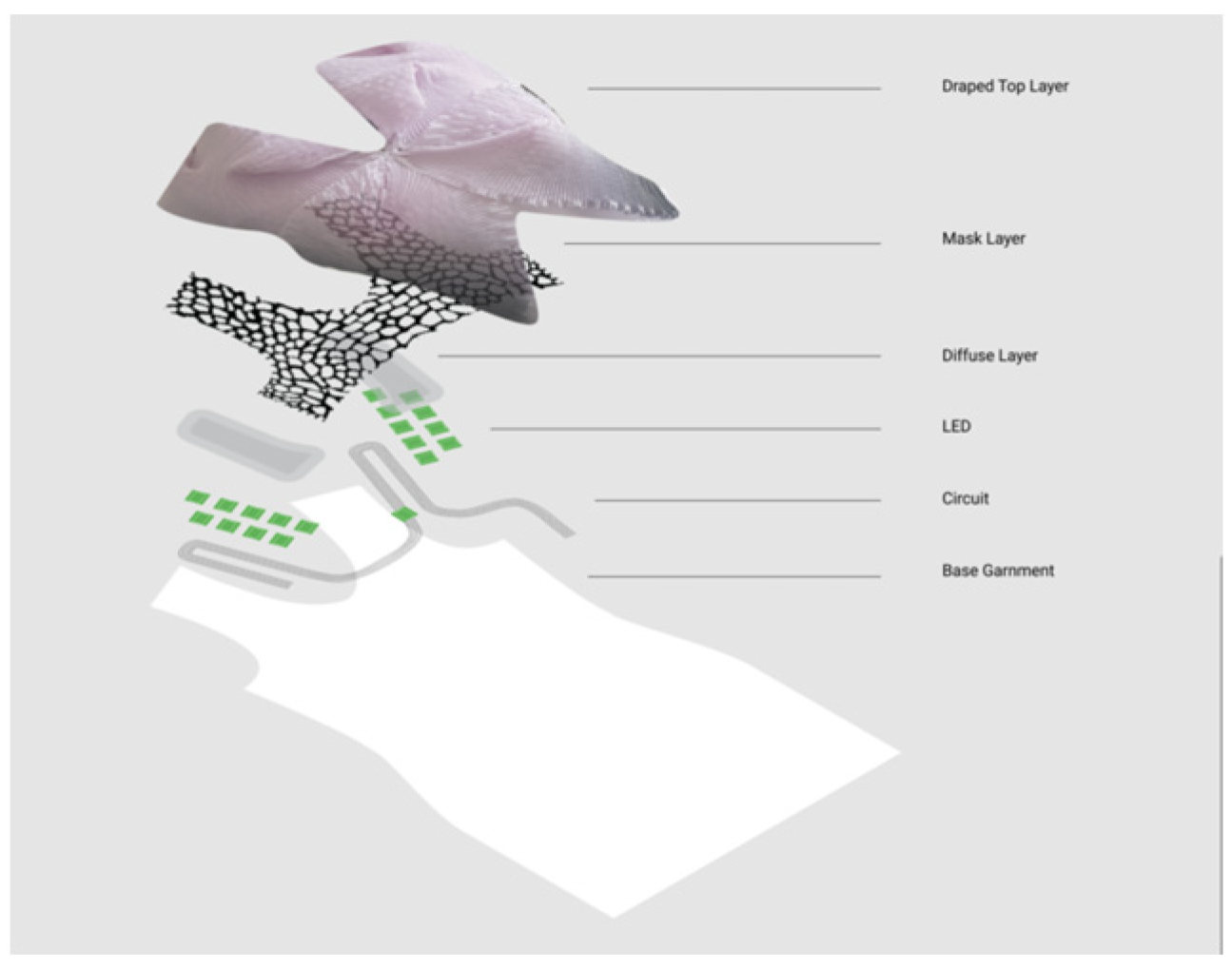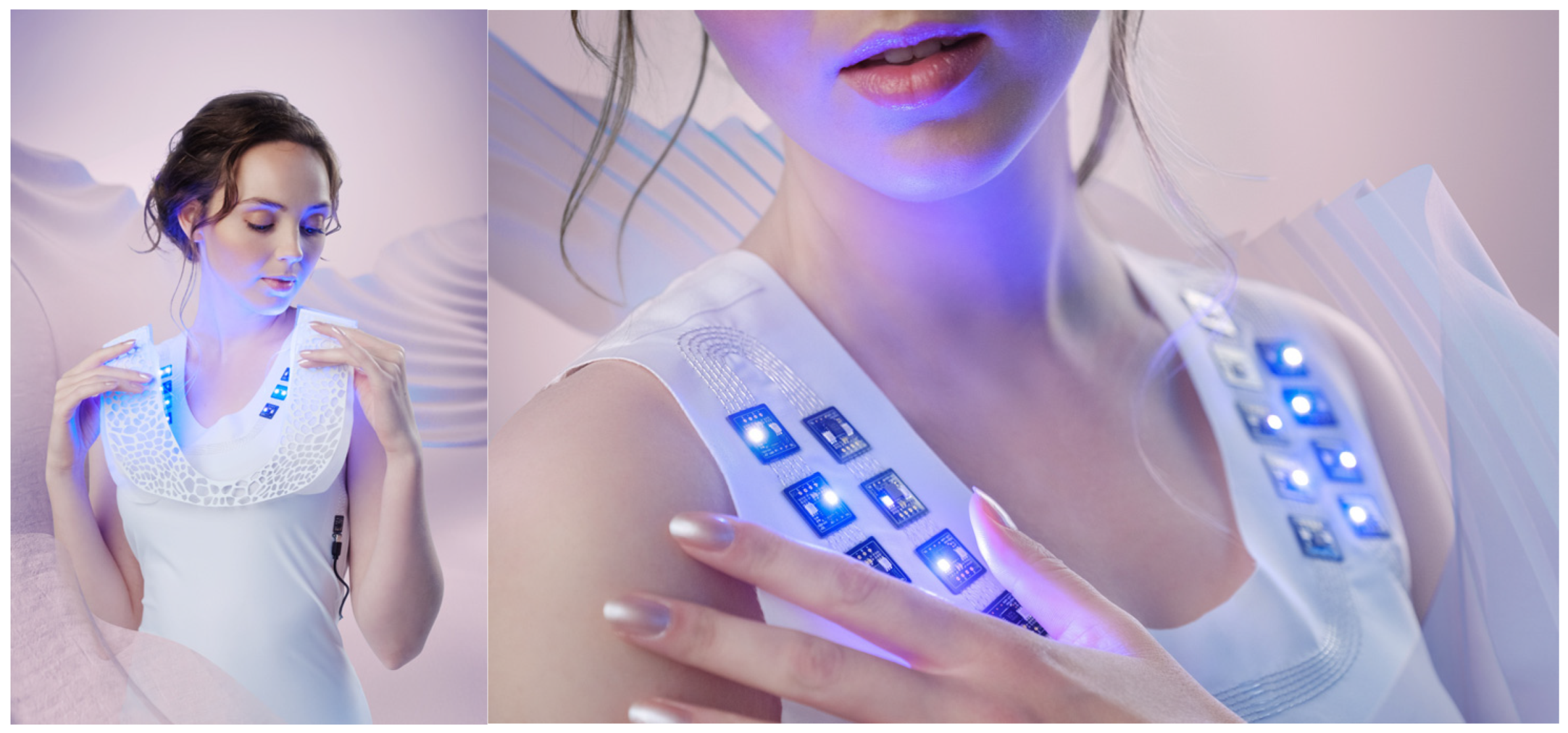Second Skins: Exploring the Challenges and Opportunities for Designing Adaptable Garments Using E-Textile †
Abstract
1. Introduction
2. Design Process
2.1. Soft Actuators
2.2. Modular Design Approach
2.3. Outergarments
3. Reflection and Discussion
3.1. The Gap between Research and Reality
3.2. The Evolution of Fashion Tech
3.3. The Time Frames of Wearable Innovation
3.4. Sustainability Positioning
3.5. Sustainability and Creativity Balance and Context
Author Contributions
Funding
Institutional Review Board Statement
Informed Consent Statement
Data Availability Statement
Acknowledgments
Conflicts of Interest
References
- Hauser, S.; Oogjes, D.; Wakkary, R.; Verbeek, P.P. An annotated portfolio on doing postphenomenology through research products. In Proceedings of the 2018 Designing Interactive Systems Conference, Hong Kong, China, 9–13 June 2018; pp. 459–472. [Google Scholar] [CrossRef]
- Wakkary, R.; Maestri, L. Aspects of Everyday Design: Resourcefulness, Adaptation, and Emergence. Int. J. Hum. Comput. Interact. 2008, 24, 478–491. [Google Scholar] [CrossRef]
- Gaver, W.W.; Krogh, P.G.; Boucher, A.; Chatting, D. Emergence as a Feature of Practice-based Design Research. In Proceedings of the 2022 ACM Designing Interactive Systems Conference: Digital Wellbeing, Virtual, 13–17 June 2022; pp. 517–526. [Google Scholar] [CrossRef]
- Frankjaer, R.; Dalsgaard, P. Understanding Craft-Based Inquiry in HCI. In Proceedings of the 2018 on Designing Interactive Systems Conference, Hong Kong, China, 9–13 June 2018; pp. 473–484. [Google Scholar] [CrossRef]
- Devendorf, L.; Rosner, D.K. Beyond Hybrids. In Proceedings of the 2017 Conference on Designing Interactive Systems, Edinburgh, UK, 10–14 June 2017; pp. 995–1000. [Google Scholar] [CrossRef]
- Berzowska, J.; Kelliher, A.; Rosner, D.K.; Ratto, M.; Kite, S. Critical Materiality. In Proceedings of the Thirteenth International Conference on Tangible, Embedded, and Embodied Interaction, Tempe, AZ, USA, 17–20 March 2019; pp. 691–694. [Google Scholar] [CrossRef]
- da Rocha, B.G.; Andersen, K.; Tomico, O. Portfolio of Loose Ends. In Proceedings of the 2022 ACM Designing Interactive Systems Conference: Digital Wellbeing, Virtual, 13–17 June 2022; pp. 527–540. [Google Scholar] [CrossRef]
- Matthews, B.; Wensveen, S. Prototypes and prototyping in design research. In Routledge Companion to Design Research; Paul, A., Rodgers, J.Y., Eds.; Routledge: London, UK, 2014; pp. 262–276. Available online: https://www.researchgate.net/publication/270511639 (accessed on 30 June 2019).
- Thalman, C.; Artemiadis, P. A review of soft wearable robots that provide active assistance: Trends, common actuation methods, fabrication, and applications. Wearable Technol. 2020, 1, e3. [Google Scholar] [CrossRef]
- Li, M.; Pal, A.; Aghakhani, A.; Pena-Francesch, A.; Sitti, M. Soft actuators for real-world applications. Nat. Rev. Mater. 2021, 7, 235–249. [Google Scholar] [CrossRef] [PubMed]
- Kilic Afsar, O.; Shtarbanov, A.; Mor, H.; Nakagaki, K.; Forman, J.; Modrei, K.; Jeong, S.H.; Hjort, K.; Höök, K.; Ishii, H. OmniFiber: Integrated Fluidic Fiber Actuators for Weaving Movement based Interactions into the Fabric of Everyday Life. In Proceedings of the 34th Annual ACM Symposium on User Interface Software and Technology, Virtual, 10–14 October 2021; pp. 1010–1026. [Google Scholar] [CrossRef]
- Sanchez, V.; Payne, C.J.; Preston, D.J.; Alvarez, J.T.; Weaver, J.C.; Atalay, A.; Boyvat, M.; Vogt, D.M.; Wood, R.J.; Whitesides, G.M.; et al. Walsh. Smart Thermally Actuating Textiles. Adv. Mater. Technol. 2020, 5, 2000383. [Google Scholar] [CrossRef]
- Connolly, F.; Wagner, D.A.; Walsh, C.J.; Bertoldi, K. Sew-free anisotropic textile composites for rapid design and manufacturing of soft wearable robots. Extreme Mech. Lett. 2019, 27, 52–58. [Google Scholar] [CrossRef]
- Second Skins Research on Responsive and Adaptive Materials. Available online: https://re-fream.eu/second-skins-research-on-responsive-and-adaptive-materials/ (accessed on 12 December 2022).
- Planetary Design Circle—A Holistic and Strategic Design Tool—Re-FREAM. Available online: https://re-fream.eu/planetary-design-circle-a-holistic-and-strategic-design-tool/ (accessed on 12 December 2022).
- Garbacz, K.; Stagun, L.; Rotzler, S.; Semenec, M.; von Krshiwoblozki, M. Modular E-Textile Toolkit for Prototyping and Manufacturing. Proceedings 2021, 68, 5. [Google Scholar] [CrossRef]
- von Krshiwoblozki, M.; Linz, T.; Neudeck, A.; Kallmayer, C. Electronics in Textiles-Adhesive Bonding Technology for reliably embedding Electronic Modules into Textile Circuits. Adv. Sci. Technol. 2012, 85, 1–10. [Google Scholar] [CrossRef]
- Toeters, M. Unfolding Fashion Tech: Pioneers of Bright Futures 2000–2020; Onomatopee: Eindhoven, The Netherlands, 2019. [Google Scholar]
- Gnahm, T. (Wear it GmbH, Berlin, Germany). Personal communication, 2021.
- Eppinger, E.; Slomkowski, A.; Behrendt, T.; Rotzler, S.; Marwede, M. Design for Recycling of E-Textiles: Current Issues of Recycling of Products Combining Electronics and Textiles and Implications for a Circular Design Approach. In Recycling—Recent Advances; Saleh, H.M., Hassan, A.I., Eds.; IntechOpen: London, UK, 2022. [Google Scholar] [CrossRef]



Disclaimer/Publisher’s Note: The statements, opinions and data contained in all publications are solely those of the individual author(s) and contributor(s) and not of MDPI and/or the editor(s). MDPI and/or the editor(s) disclaim responsibility for any injury to people or property resulting from any ideas, methods, instructions or products referred to in the content. |
© 2023 by the authors. Licensee MDPI, Basel, Switzerland. This article is an open access article distributed under the terms and conditions of the Creative Commons Attribution (CC BY) license (https://creativecommons.org/licenses/by/4.0/).
Share and Cite
Beemer, M.; Dils, C.; Nachtigall, T. Second Skins: Exploring the Challenges and Opportunities for Designing Adaptable Garments Using E-Textile. Eng. Proc. 2023, 30, 9. https://doi.org/10.3390/engproc2023030009
Beemer M, Dils C, Nachtigall T. Second Skins: Exploring the Challenges and Opportunities for Designing Adaptable Garments Using E-Textile. Engineering Proceedings. 2023; 30(1):9. https://doi.org/10.3390/engproc2023030009
Chicago/Turabian StyleBeemer, Malou, Christian Dils, and Troy Nachtigall. 2023. "Second Skins: Exploring the Challenges and Opportunities for Designing Adaptable Garments Using E-Textile" Engineering Proceedings 30, no. 1: 9. https://doi.org/10.3390/engproc2023030009
APA StyleBeemer, M., Dils, C., & Nachtigall, T. (2023). Second Skins: Exploring the Challenges and Opportunities for Designing Adaptable Garments Using E-Textile. Engineering Proceedings, 30(1), 9. https://doi.org/10.3390/engproc2023030009





